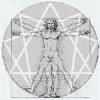B1216 <=> B1218 (BTG XLVIII From the Author, p. 1217)
And it is this that explains the incongruity, always observed even by the average man during his passive state, in the several associations having nothing in common, which simultaneously flow within him.
The said impressions in the common presence of a man are perceived owing to the three, as it were, apparatuses in him – as there are apparatuses in general in the presences of all animals – acting as perceivers for all the seven what are called “planetary-gravity-center-vibrations.”
The structure of these perceptive apparatuses is the same in all the parts of the mechanism.
They consist in adaptations recalling clean wax phonograph disks; on these disks, or, as they might otherwise be called, “reels,” all the impressions received begin to be recorded from the first days after the appearance of a man in the world, and even before, during the period of his formation in his mother’s womb.
And the separate apparatuses constituting this general mechanism possess also a certain automatically acting adaptation, owing to which newly arriving impressions, in addition to being recorded alongside those previously perceived and similar to them, are also recorded alongside those impressions perceived simultaneously with these latter.
Thus every impression experienced is inscribed in several places and on several reels, and there, on these reels, it is preserved unchanged.
These impressed perceptions have such a property that from contact with homogeneous vibrations of the same quality, they, so to say, “rouse themselves,” and there is then repeated in them an action similar to the action which evoked their first arising.
